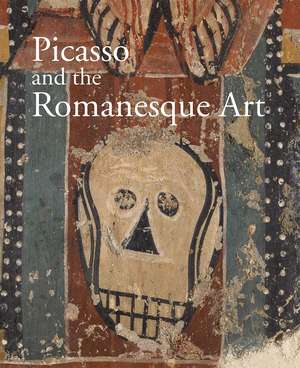Romanesque – Picasso
Autor Juan José Lahuerta, Emilia Philippoten Limba Engleză Paperback – 15 mai 2017
This beautifully illustrated book, the catalog for an exhibition on view at the National Museum of Art of Catalonia in Barcelona and coorganized with the Picasso Museum in Paris, explores important affinities between Picasso and Romanesque art. Using two key moments as starting points, Juan José Lahuerta and Emilia Philippot first discuss the summer of 1906, when Picasso stayed in the village of Gòsol in the Catalan Pyrenees, and then turn to 1934, as he visited the Romanesque art collections of what is today the National Museum of Art of Catalonia.
Picasso’s discovery of the Romanesque nurtured his interest in other “primitive” or ethnographic art, later echoed in such decisive works as Les Demoiselles d’Avignon. Importantly, while Lahuerta and Philippot avoid any attempt to trace direct Romanesque influences on Picasso—as they note, his work consistently escapes such linear accounts—they do demonstrate that Picasso’s interest in the twelfth-century sculpture Virgin from Gósol, his lifelong fascination with the theme of the crucifixion, and his study of the skull all reflect elements that were also of major importance in Romanesque art and architecture. What these shared features allow, Lahuerta and Philippot ultimately argue, is not only a richer understanding of Picasso’s work, but also a rediscovering and reinvention of Romanesque art in our contemporary moment, causing the medieval to become refreshingly and paradoxically modern.
Picasso’s discovery of the Romanesque nurtured his interest in other “primitive” or ethnographic art, later echoed in such decisive works as Les Demoiselles d’Avignon. Importantly, while Lahuerta and Philippot avoid any attempt to trace direct Romanesque influences on Picasso—as they note, his work consistently escapes such linear accounts—they do demonstrate that Picasso’s interest in the twelfth-century sculpture Virgin from Gósol, his lifelong fascination with the theme of the crucifixion, and his study of the skull all reflect elements that were also of major importance in Romanesque art and architecture. What these shared features allow, Lahuerta and Philippot ultimately argue, is not only a richer understanding of Picasso’s work, but also a rediscovering and reinvention of Romanesque art in our contemporary moment, causing the medieval to become refreshingly and paradoxically modern.
Preț: 205.96 lei
Preț vechi: 249.98 lei
-18% Nou
Puncte Express: 309
Preț estimativ în valută:
39.44€ • 40.25$ • 33.18£
39.44€ • 40.25$ • 33.18£
Carte indisponibilă temporar
Doresc să fiu notificat când acest titlu va fi disponibil:
Se trimite...
Preluare comenzi: 021 569.72.76
Specificații
ISBN-13: 9788480432870
ISBN-10: 848043287X
Pagini: 208
Ilustrații: 170 color plates, 20 halftones
Dimensiuni: 220 x 270 x 17 mm
Greutate: 0.98 kg
Editura: University of Chicago Press
ISBN-10: 848043287X
Pagini: 208
Ilustrații: 170 color plates, 20 halftones
Dimensiuni: 220 x 270 x 17 mm
Greutate: 0.98 kg
Editura: University of Chicago Press
Notă biografică
Juan José Lahuerta is chief curator at the National Museum of Art of Catalonia in Barcelona and professor of history of art at the Barcelona School of Architecture. Emilia Philippot is curator at the Picasso Museum in Paris. Graham Thomson, who studied philosophy and literature at the University of Edinburgh, has translated poetry and prose from Catalan, Spanish, French, Italian, and Portuguese. Richard Lewis is a translator who specializes in art catalogs.
